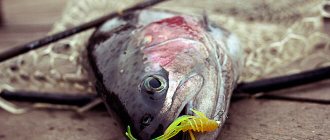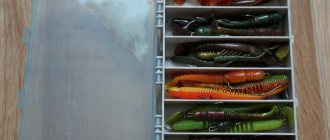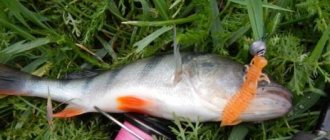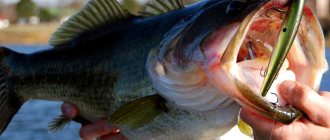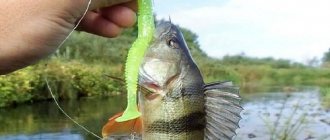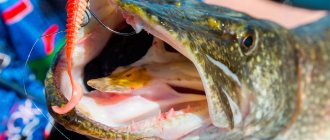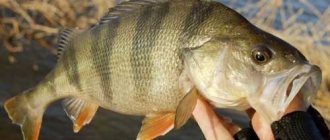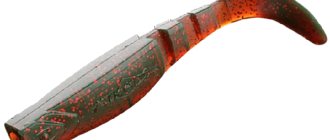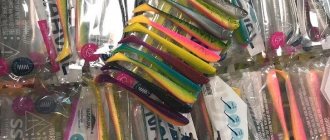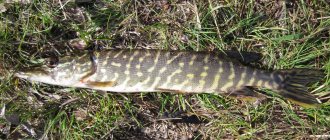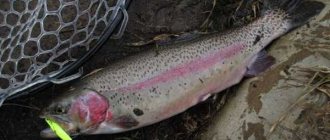Nowadays, it is difficult to meet a spinning fisherman who would not be familiar with silicone baits. Even if he is a fan of other, more traditional lures, he has had to hold them in his hands or watch one of his colleagues successfully fish with silicone.
Silicone baits have three advantages that make them competitive compared to other baits. This:
- The widest selection of baits, allowing you to choose the optimal one for almost any spinning fishing conditions;
- The fact that most of the predatory fish and some non-predatory fish that live in our waters can be caught using silicone bait;
- Relatively low price.
The list of predatory fish that can be seduced with silicone bait includes not only the usual perch, pike and pike perch, but also asp, chub and trout. On occasion, bream, rudd, silver bream, sleeper and sabrefish are not averse to tasting silicone.
The variety of silicone baits can confuse a novice spinning angler, so it would be useful to consider by what criteria these baits can be classified.
Classification of silicone baits
Body Shape
Twisters
Twisters are perhaps the most popular silicone baits. A typical twister has a cigar-shaped body and tail. There can be one, two, four tails, and sometimes instead of a tail, a twister can have a bunch of silicone threads. With a twister you can cast quite far, and you can catch any fish with it.
Twisters are used when fishing with a jig spinning rod, a retractable leash and on a drop-shot rig, as well as in some very exotic fishing methods, such as fishing in “toads” with a twister on an offset hook with or without a weight.
Vibrotails
The vibrotail is a silicone bait made in the shape of a fish. The shape of the vibrotail itself can be very different: narrow, wide, laterally flattened, cigar-shaped, etc. The tail can be large or small.
All these characteristics are important under different fishing conditions: in the current it is customary to use vibrating tails with a protruding body and a small tail, and in still water it is better to fish with baits with a wider body and a large tail, which creates powerful vibrations in the water. The vibrotail, like the twister, is widely used, although it is less often used in drop-shot rigs and on a retractable leash.
Silicone worms
Silicone worms came into fishing use much later than vibrotails and twisters. This was facilitated by the emergence of new mounting methods, as well as the fact that almost all silicone worms are edible and, therefore, can be used in situations where the fish have the opportunity not only to see and feel the bait with the lateral line, but also to taste it. The element of silicone worms is a retractable leash and a drop shot.
Slugs
Slugs are elongated, narrow, elongated baits that do not have any elements that provide active play. Therefore, in order for them to successfully catch fish, they need to be given some kind of movement, that is, animate. They are also used when fishing with a lead or drop-shot, although in the current they can be quite successfully used, mounted on a “eared” weight with a stepped retrieve.
Creatures
Creatures are silicone baits depicting any lizards, squids, insects or their larvae. Creatures appeared on the fishing market relatively recently, so they are only available in an edible version and their purpose is the same as that of slugs and silicone worms, i.e., catching low-active fish with slow retrieval.
Drop shot fish
For fishing with drop-shot equipment, special baits are produced that have the shape of a fish and a fork-shaped tail. It is believed that they attract predators better than other baits, using a very slow retrieve with pauses and the bait playing in one place, which, in fact, is the meaning of this equipment. However, some anglers very successfully use them in combination with the “Cheburashka” when jig fishing.
Octopuses
Specialized baits that can be used in a variety of situations, provided they are installed correctly. If you mount an octopus with a treble hook, install a spinner blade in front of it, and then attach it all to an “eared” weight, you will get a catchy jig bait. By placing the octopus on the tee with the tentacles forward, you can catch pike in the grass windows.
Silicone frogs
Silicone frogs are designed for catching pike in toad traps. The silicone frog is 100% hook-free and pikes attack it very often, but, unfortunately, the percentage of bites realized when fishing with this bait is quite low.
In addition to the types of silicone baits listed above, wobblers and vibes (rattlins) made from very dense silicone are also currently produced.
Silicone bait size
In fishing stores you can find silicone baits ranging in size from an inch to giant 10-inch ones. Each size has its own application.
Microjig
This type of fishing has many fans. Although the size of the prey during such fishing cannot cause admiration, elegant light tackle allows the spinner to experience emotions when fishing for a small bass, comparable to those experienced by an angler when fishing for a large pike with heavy class tackle. But sometimes you come across trophies.
In microjig, silicone baits measuring 1-1.5 inches are most often used. They are mounted on a jig head or hook with a Cheburashka. The weight of weights when fishing with a microjig can sometimes be less than 1 gram.
Shore fishing
To catch medium to large fish from the shore, 3-4 inch lures are typically used. Lures of this size, especially those mounted on a “eared” weight, can be cast quite far, while problems may arise with larger baits. From the shore you can fish with a jig spinning rod, a retractable leash and a drop shot - the type of bait is selected in accordance with the fishing method.
Trolling
When trolling, silicone baits are rarely used - they still cannot compete with wobblers. If you still need to fish by trolling with silicone, it is better to use lures made in the shape of rattlin. At low speed, this bait will have a very decent game, and a predator may well be tempted by such a gift.
You can fish with silicone in another way, but then you have to sit down with the oars. Fans of “track” fishing fish with silicone in the following way: make a couple of strokes, then stop and continue in the same spirit. It turns out to be something like stepped wiring. It is optimal to use a simple jig head. The size of the bait for pike perch is 50-70 mm, for pike - 70-90 mm.
Silicone bait color
The color palette of silicone baits on the windows of fishing stores is breathtaking. However, in many ways this is designed for inexperienced anglers. An experienced spinner knows that his arsenal should include the following baits:
- Natural colors. Mother of pearl, white;
- Bright colors. Yellow, pink;
- Annoying colors. Orange, lemon;
- Machine oil colors.
Autumn
Outside the window it’s the beginning of autumn. Despite some changes in nature, the striped robber still continues to live according to the summer schedule. All the same “cauldrons” of a fattening predator, only more pelagic than surface. During such long outings, large perch prefer larger prey - and, as a result, respond well to “silicone” in the size of 3 - 3.3 inches.
With a slight decrease in its activity at a promising point, I reduce the size of the bait to 2.5 - 2.8 inches and catch the predator. Or you can check a few more places and try to find a more accommodating humpback whale. To search, I zoom in again to three inches. By the way, my best fishing for massive large fish occurred in the first half of September.
By the end of the first autumn month, the nights become longer and colder - the water temperature drops significantly. This serves as a signal to the tabby that winter is just around the corner - and it’s time to get fat. The predator also hunts for large prey; it is not averse to feasting on young fingerlings, which by this time gather in numerous schools and move to deeper areas of reservoirs.
Therefore, in a specific place at a certain time, perch can be successfully caught with fairly large baits of 3 - 3.5 inches, and at another working point it will respond better to “silicone” no more than 2.5 inches. The favorites of early autumn are all kinds of vibrotails, as well as imitations of various worms and larvae.
For several seasons now, in the second half of October - November, I have been purposefully hunting for trophy perch. Examining the stomachs of those individual humpback whales that I take for my household, I came to the conclusion that the predator at this time prefers decent-sized prey, mainly large bleak and medium-sized roach. Therefore, in late autumn I don’t go shallow with baits - minimum 3, maximum 4 - 4.2 inches. In addition, the use of such large “silicone” minimizes the bites of the small striped bully.
The favorites of pre-winter fishing are exclusively vibrotails with high-frequency “game”. But there are no rules without exceptions. It is well known that in the pre-winter period, most underwater inhabitants shift to deep-water sections of reservoirs (channel irrigation and the channel itself), where the most comfortable conditions develop at this time. The exception is not the young of the year of various fish, which hang in numerous schools at the bottom in the deep waters of reservoirs.
Over the past ten years, only twice, and absolutely by accident, in the second half of November, have I discovered such accumulations of small things in the bed of the Minsk Sea and the Vileika Reservoir. And having reduced the bait to one to two inches (I caught it with small twisters), I caught from five to eight large perches in the area of a kilo to one and a half kilos near the numerous fry! An interesting fact is that all the humpback whales caught were stuffed to capacity with small fish the size of the “silicone” used.
To draw final conclusions, as well as to complement the overall picture, I will give a vivid example from personal practice. The spring of 2021 was not very late; my first jig fishing trips on suburban reservoirs took place already in the last days of March. Before spawning, decent perch confidently responded to “silicone” in the size of 2.8 – 3.3 inches. But April and May turned out to be quite cold. And the process of reproduction in most fish species, including perch, has been very extended, shifting by almost a month.
The activity of the perch at this time decreased significantly - during fishing we managed to get almost a couple of bites. As for weather conditions, the beginning of summer was also very cold. Towards the end of June it became warmer, and temperatures began to approach normal for this time. But the perch was capricious, its activity manifested itself only in the form of short outings, and even then irregularly. On one of the fishing trips, I continued to experiment, reducing the size of the “silicone” to 1.4 inches. And it worked - in a few hours I landed two humpback whales for half a kilo, while still missing a couple of good bites.
I won’t bore you with all the details; I’ll just note the nuances and features of summer fishing that year. While visiting two suburban reservoirs in the second half of the summer, I completely switched to fishing with small “silicone” 1 - 1.8 inches long. I don’t remember such activity from a large perch for a long time - a discovered schooling predator at some point confidently attacked micro-baits with enviable frequency. During periods of striped feeding frenzy, I tried to get larger - in the end, only a few bites by inertia, and then the bite subsided. And as soon as I returned the small vibrating tail or twister, the humpback whales stood in line behind them.
Meanwhile, most spinning anglers complained about the lack of bite at this time. And at the end of August - beginning of September I had several fantastic fishing trips, when in promising places there were bites of large perch for 6 - 8 hours, and almost without a break. And he responded exclusively to small “silicone”. Productive trips continued until mid-September, then it got colder, and it was time to radically change fishing tactics. But that is another story.
Next, I will try to understand this food preference of large perch during the period under review. It was not for nothing that I mentioned the cold spring and late spawning. By mid-summer, the hatched fry was smaller in size than at the same time in previous years. And the relatively cold summer, not counting several hot weeks at the beginning of August, contributed to the fact that the striped robber almost completely switched to feeding on young of the year. Therefore, the predator preferred smaller “silicone”. I identified the humpback whale’s changed food priorities in time, which allowed me to achieve excellent results.
Let me summarize. The preferences of perch for one or another size of silicone baits in a certain time interval are characterized, first of all, by the peculiarities of climate formation in the region, both in the short and long term, as well as by the conditions of a particular reservoir with its seasonal fluctuations in water level.
The population dynamics of perch in a particular body of water is also worth taking into account. If an observant fisherman approaches each fishing trip thoughtfully, constantly experiments, and at the same time has a rich arsenal of baits, he will almost always be able to pick up the key (one of its components is the bait) to a rather finicky large predator.
Types of silicone by material of manufacture
Soft silicone
Most lures are made of soft silicone. Such baits can be used with any type of equipment. They are quite unpretentious and can withstand a certain number of bites until pike teeth or pike perch fangs put an end to their existence. Small cuts can be healed while fishing using a turbocharged lighter. When using a jig head, the front of the bait is broken by the tooth at the base of the hook; double-mounted baits last longer.
Hard silicone
Some companies produce baits made of hard silicone. They last longer and stay on the hook better without slipping off it.
Attention! Hard silicone baits are best used when fishing in the current. In this case, the tail of the vibrotail should be small, the tail of the twister should be narrow, and the baits themselves should be driven.
Edible silicone
The idea of edible silicone belongs to Japanese designers of fishing products. They came up with compounds that, when added to the body of the bait, have an attractant effect for predatory fish and retain their properties for a long time. The formulas of these substances are kept secret.
Edible silicone baits are widely used in our country, especially when fishing for perch and pike perch. They have already proven their effectiveness when used in jig spinning, retractable leader and drop shot. The price of such baits, unfortunately, is higher than regular rubber.
Floating silicone
In some situations, the buoyancy of a silicone bait plays an important role. Most baits are sinking, and sometimes it is required that the bait does not fall to the bottom when the retrieve is stopped, but is suspended or slowly floats up. This is especially true when fishing with a retractable leash.
To achieve the desired effect, enterprising fishermen make floating baits with their own hands. To do this, a cut is made in the body of the bait into which a piece of floating material is inserted or construction foam is simply pumped in. On sale you can find ready-made baits made of floating silicone, for example, the Samba vibrating tail from Mann's. Mounted on a hook in combination with a “Cheburashka”, this bait, when falling to the bottom, remains standing vertically and the predator has an additional chance to attack it.
Silicone imitation animal baits
The Berckley company has been producing various imitations of animal baits called PowerBait for quite some time. On sale you can find bloodworms, maggots and worms. They actually have edible properties and fish eat them. Of course, they are not a complete replacement for a natural product, and floaters still prefer natural baits, but they have found application among winter lure anglers.
Healthy! Putting a pair of bloodworms or maggots on the hook of a winter lure is very effective when hunting for inactive perch. For this purpose, it is better to use a spinner with a chain and a single hook.
It should be added that now some fishermen have begun to cast silicone baits themselves. To do this, you need to have a microwave oven, casting molds and, preferably, a hood, since liquid silicone fumes are harmful to health. Making silicone baits at home allows you to achieve the required color scheme, the desired body shape and the ability to save money from the family budget.
Spring
Hunting for humpback salmon in the spring is carried out exclusively from the shore - due to the spawning ban. Immediately after the ice melts, I can achieve the best results by using a 2.5-3.2-inch-long silicone jig in the rig. These are mainly all kinds of vibrating tails and rippers, and much less often - twisters.
The preference for striped robber of this size is due, in my opinion, to several factors. Firstly, in order to quickly restore strength after winter, the predator begins to feed heavily. It also prepares for the all-important process of reproduction. Therefore, the humpback whale prefers larger prey at this time. And secondly, the main size of its food item (juveniles of various fish species that appeared a year ago) in reservoirs in early spring is comparable to the above-mentioned sizes of “silicone”. It is now more difficult to interest humpback whales with smaller baits.
Soon the perch will begin spawning and its feeding activity will decrease significantly. At this time, he prefers relatively small prey. Then the size range of my working baits will narrow to 2 - 2.5 inches. In addition, in mid-spring, numerous bugs and boogers begin to appear in reservoirs, and arthropods (crayfish) also awaken. And the humpback whale is not averse to feasting on all these living creatures along with the fry. Moreover, a predator will need much less effort to catch it than when he chases young fish in shallow waters.
Now the favorites are a variety of vibrating tails and creature baits. By the way, about a year and a half ago I developed several silicone baits that imitate aquatic insects living in the reservoirs of our region. And last spring, this creative “silicone” was successfully tested at suburban reservoirs. From the very first fishing trips, large perch began to take a keen interest in my rubber imitations of boogers - provided that the animation was correctly selected for each individual model.
A short time after spawning, the perch experiences the so-called zhor. The predator again begins to feed intensively, restoring the strength spent in the process of reproduction. Now the size of the bait practically does not matter; the humpback fish can attack both a small vibrating tail and a voluminous, fleshy twister.
It is much more important for the fisherman to be in the right place in the reservoir at this time. The size range of “silicone” is in a wide range from 2 to 3.5 - 4 inches. Both active baits and various “creatures” are used. All kinds of crayfish imitations have proven themselves well in the second half of spring.
Depending on weather conditions, zhor can last from one to two to three weeks. After which there is a decline in the striped food activity. The predator moves to deeper water areas of reservoirs, where it feeds on short outlets, preferring mainly medium-sized “silicone”.
Closer to summer, the best performance is achieved when using baits 2 - 2.5 inches long in the rig. The favorites now will be active “silicone” (small vibrating tails and rippers), as well as various imitations of worms, leeches and caterpillars.
Storing silicone baits
It is necessary to store ordinary silicone baits in boxes designed for this purpose, which are offered in abundance by trade. Most boxes are made from a silicone-resistant polymer, but you may occasionally purchase a box made from a material that will melt the silicone. It is better to get rid of such a box.
Important! It is advisable to store silicone baits of different colors in different compartments of the box. Silicone has the ability to shed, and when stored together, baits can acquire undesirable shades.
The edible silicone attractant loses its properties over time. In order to prolong its effect, baits should be stored in tightly sealed original packaging between fishing trips.
Tightly closed jars with artificial bloodworms and maggots are best stored in the refrigerator.
Installation of silicone baits
There are different types of installations of silicone baits - on single, double, and sometimes triple hooks. On a jig head, the bait is simply put on the hook head first. The bait is put on an offset hook as follows: the front part of the bait is pierced with the hook, then it is moved to the eye of the hook, then the sting is inserted into the body of the bait closer to its back.
For mounting on a double, it is better to use hooks with a long shank, for example, Saikyo. The hooks are slightly moved apart, one hook pierces the side of the bait, then the hook is threaded through the body, and after both hooks are on both sides of the bait, the eye of the double is pressed through the body of the bait until it appears outward.
There are offset hooks with a spring attached to the eye of the hook. The front part of the bait is screwed onto the spring, then the hook tip is inserted into the body of the bait. When installing the bait on an offset hook, you must ensure that the bait, upon completion of installation, is positioned on the hook exactly as needed, and not upside down.
These types of rigs can be used when fishing with jig-spinning, retractable leash, drop-shot, Texas and Carolina rigs.
